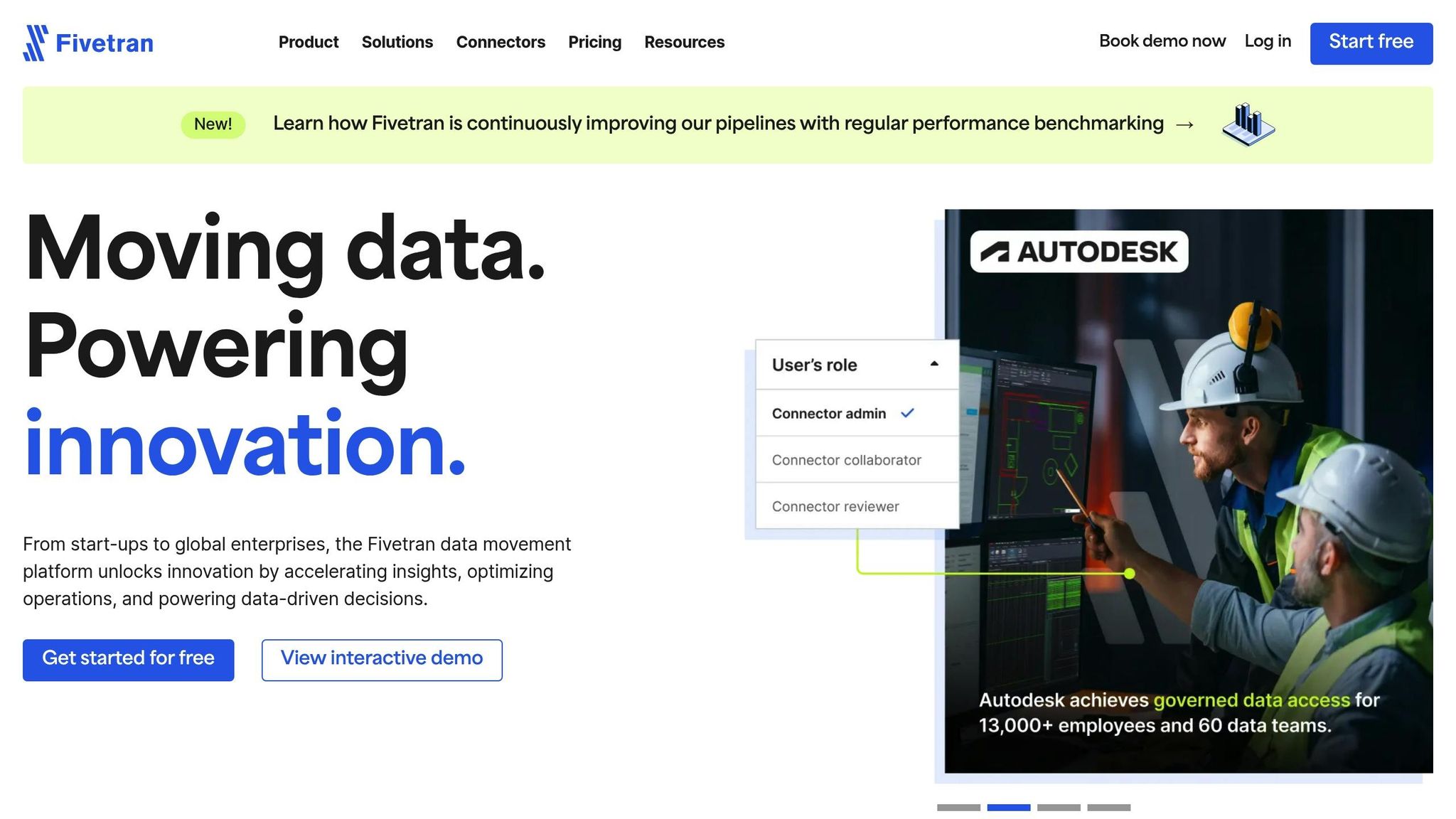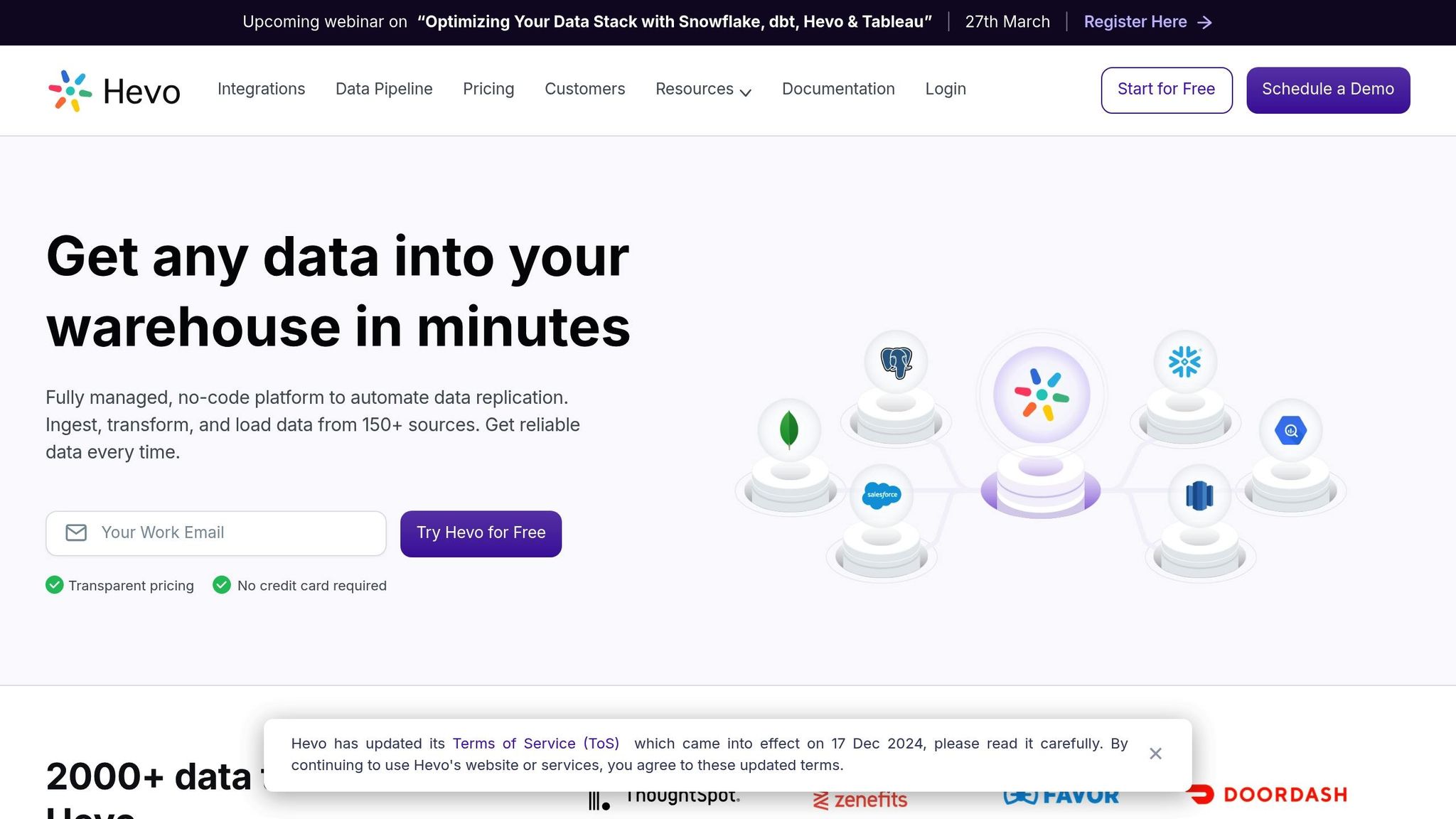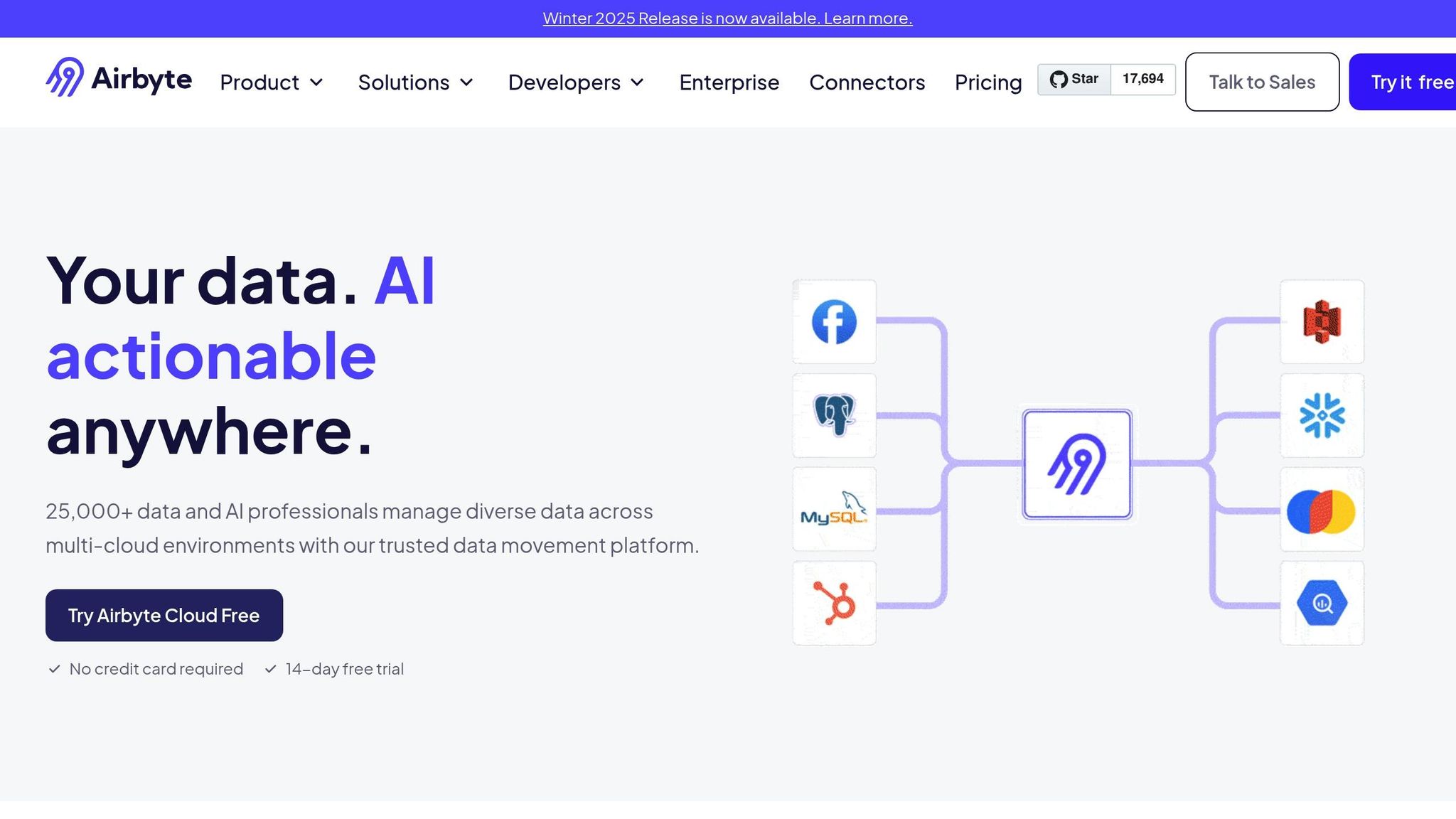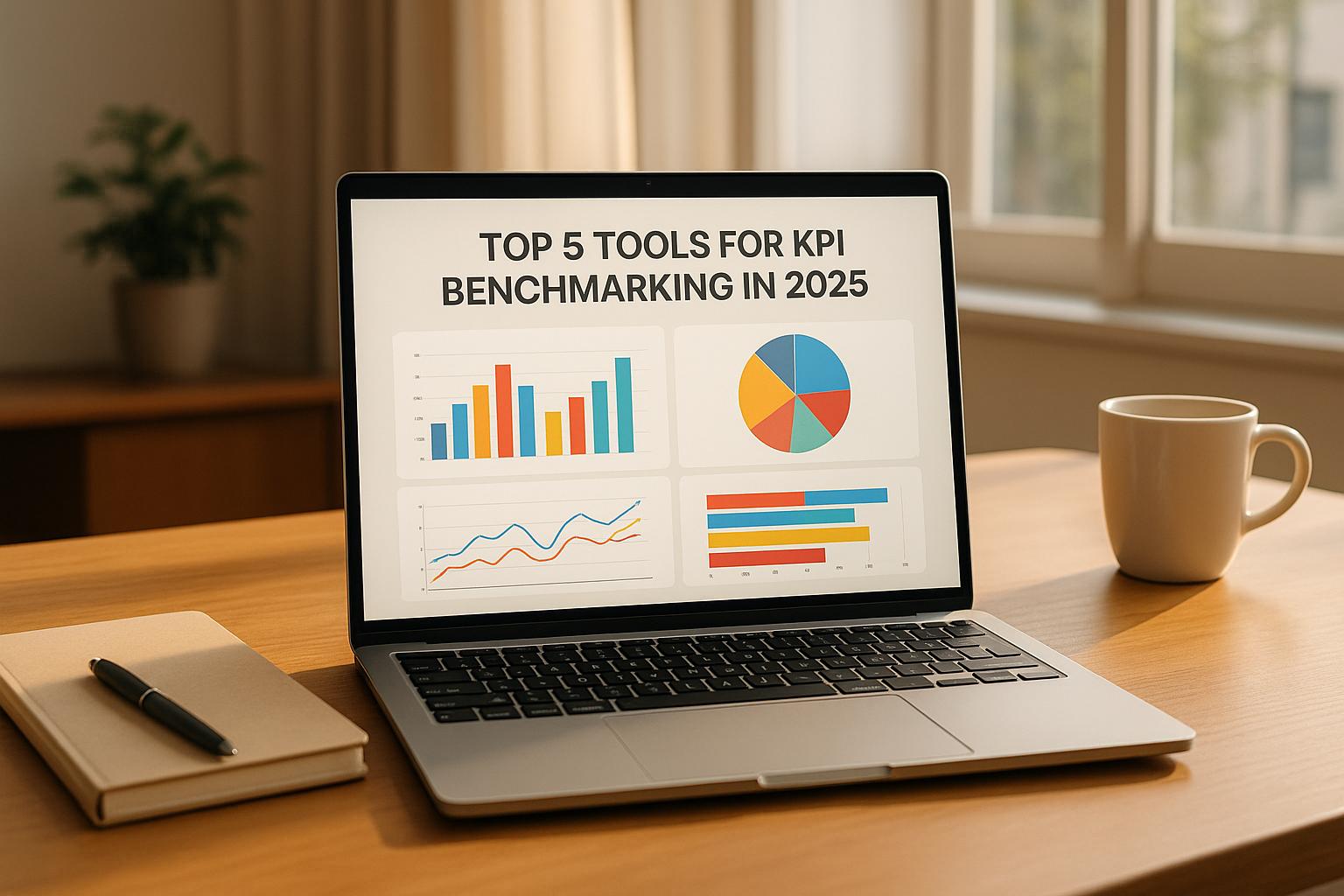In today’s fast-paced marketing world, real-time data integration tools help businesses make quick decisions by combining data from multiple platforms instantly. Here’s a quick overview of the top tools and their key features:
- Improvado: Simplifies marketing data with automated scheduling and cross-platform standardization.
- Fivetran: Automates data pipelines with minimal setup and change data capture (CDC).
- Hevo Data: Offers a no-code interface with real-time monitoring and pre-built templates.
- Estuary: Focuses on continuous data movement and scalability for live tracking.
- Airbyte: Provides customizable connectors and flexible deployment options.
Quick Comparison
| Tool | Latency | Pricing Options | Best For |
|---|---|---|---|
| Improvado | Frequent updates | Tiered options | Marketing-specific integrations |
| Fivetran | Low latency | Consumption-based | Enterprise data pipelines |
| Hevo Data | Low latency | Flexible tiered plans | No-code implementations |
| Estuary | Ultra-low latency | Custom pricing | Real-time streaming |
| Airbyte | Consistent | Tiered options | Customizable solutions |
These tools support key features like sub-minute latency, multiple connectors, and scalable performance. Choose based on your data needs, budget, and integration requirements.
Top 10 Data Integration Tools for Enterprises in 2024
Must-Have Features for Data Integration Tools
When choosing real-time marketing data integration tools, certain features are non-negotiable. These capabilities ensure the tool meets your marketing needs and supports efficient operations.
Speed and Processing Power
Handling large amounts of data in real time requires a tool with strong processing capabilities. Look for features such as:
- Sub-minute latency: Data should transfer from source to destination in seconds.
- Parallel processing: Manages multiple data streams at the same time.
- Error handling: Automatically detects and resolves data issues.
- Resource efficiency: Optimizes CPU and memory usage during peak times.
Quick data processing allows for timely decisions and agile campaign changes. For instance, when monitoring social media campaigns, even a short delay can mean missed chances to adjust ad spend or refine targeting.
Data Source Connections
With marketing data coming from various platforms, seamless connectivity is key. Your tool should offer:
- Native connectors: Pre-built integrations for popular marketing tools.
- Custom API support: Flexibility to link to proprietary or less common systems.
- Bi-directional sync: Imports and exports data as needed.
- Data transformation: Standardizes data formats for consistency.
It should easily connect with platforms like:
- Marketing automation tools
- CRM systems
- Social media ad platforms
- Analytics software
- Email marketing services
- E-commerce platforms
Scalability and Performance
As your operations grow, your integration tool should keep up. Critical features include:
- Elastic infrastructure: Adjusts resources automatically based on demand.
- High-volume capability: Handles larger data loads without slowing down.
- User management: Role-based access for expanding teams.
- Monitoring tools: Tracks performance with real-time metrics and alerts.
Additional features to look for:
- Performance dashboards
- Options for historical data storage
- Backup and recovery systems
- Notifications on system health
These essential features make it easier to evaluate and compare top real-time integration tools.
sbb-itb-5174ba0
5 Leading Real-Time Data Integration Tools
Here’s a look at some top tools designed for real-time marketing data integration. Each offers a unique approach and set of features to meet different needs.
Improvado

Improvado is all about simplifying marketing data management. It pulls data from multiple marketing platforms and organizes it into clear, unified dashboards. With its common data model, comparing performance across channels becomes much easier.
Key Features:
- Custom transformation rules
- Automated scheduling
- Advanced data mapping
- Cross-platform data standardization
Pricing is tiered to suit businesses of various sizes.
Fivetran

Fivetran focuses on automating data pipelines with minimal setup. Its zero-configuration connectors ensure smooth operation, while maintaining reliability.
Key Features:
- Automated schema migrations with built-in normalization
- Change data capture (CDC)
- Adherence to strict security standards
Pricing follows a consumption-based model.
Hevo Data

Hevo Data makes integration straightforward with its no-code interface, ideal for marketing teams without technical backgrounds.
Key Features:
- Automatic schema mapping
- Real-time monitoring
- Two-way synchronization
- Pre-built transformation templates
Pricing is flexible and based on usage.
Estuary

Estuary stands out for its continuous data movement, making it perfect for live campaign tracking.
Key Features:
- Automatic failover for reliability
- Enterprise-level scalability
- Built-in analytics support
- Custom stream processing
Pricing is tailored to specific data needs.
Airbyte

Airbyte offers a highly customizable experience, supporting both cloud-based and self-hosted setups.
Key Features:
- Community-driven connector development
- Tools for creating custom connectors
- Flexible deployment options
- Built-in transformation features
Plans range from basic to enterprise levels.
| Tool | Latency | Pricing Options | Best For |
|---|---|---|---|
| Improvado | Frequent updates | Tiered options | Marketing-specific integrations |
| Fivetran | Low latency | Consumption-based | Enterprise data pipelines |
| Hevo Data | Low latency | Flexible tiered plans | No-code implementations |
| Estuary | Ultra-low latency | Custom pricing | Real-time streaming |
| Airbyte | Consistent | Tiered options | Customizable solutions |
This table gives a quick snapshot of these tools, highlighting their latency, pricing structures, and ideal use cases. It sets the groundwork for comparing their costs and features in greater detail.
Tool Comparison Guide
Now that we've outlined the main features, let's dive into how each tool measures up in terms of functionality and pricing.
Key Features to Look For
The best tools typically include:
- Real-time processing: Ensures your data updates as events occur.
- Multiple connectors: Offers integration with various platforms and services.
- Flexible data transformation: Allows customization to fit your specific needs.
- Ease of use: Simplifies setup and daily operations.
- Enterprise-grade security: Protects sensitive data with robust safeguards.
Pricing Factors
Check vendor pricing to align with your data requirements and budget. Compare subscription-based plans with pay-as-you-go options to determine which model works best for your situation.
These guidelines will help you weigh your options effectively as we move toward selecting the right tool in the next section.
Summary and Next Steps
Main Points
Real-time tools for integrating marketing data play a key role in driving data-based strategies. These features are central to building effective solutions.
Tool Selection Guide
When choosing the right tool, follow a structured approach:
- Understand Your Data Needs: Consider your current data volume and how it may grow over time.
- Check Technical Compatibility:
- Identify required data sources and destinations.
- Ensure the tool's connector options match your existing tech stack.
- Assess the resources and time needed for implementation.
Some tools are better for large-scale operations, while others are tailored to mid-sized businesses.
What's Next in Data Integration
The field of real-time data integration is advancing quickly. Here are some key trends shaping the future:
- AI-Driven Automation: Machine learning is simplifying tasks like data transformation and validation.
- Edge Computing: Processing data closer to its source helps reduce delays.
- Stronger Privacy Features: Tools are increasingly focused on better data governance.
The Marketing Analytics Tools Directory is a helpful resource for comparing solutions based on your needs and use cases. Using this directory can make it easier to find a tool that fits your goals.
Apply these insights to fine-tune your integration strategy and stay ahead of industry changes.


